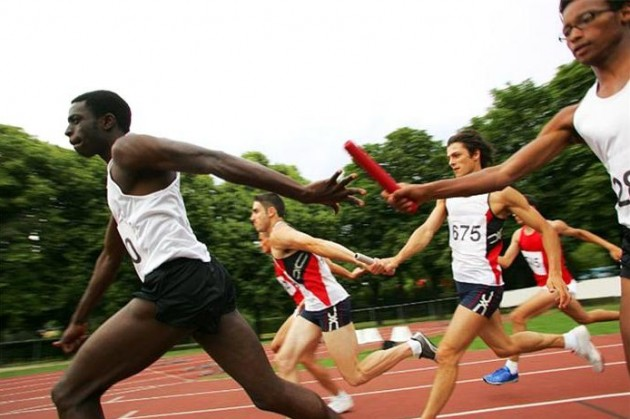|
Sprint Training Program for Relays, Part 1: Team
 To reap the extra rewards doesn't take a lot of extra work. All a team needs is a simple, consistent method that everyone understands and that always works as intended. Relay Team Selection Obviously four fast sprinters are required for a 4x100m sprint. However the athletes can vary from 100, 200 or even 400m sprinters, when used correctly. (See The Rules For Sprinters.) The first and third legs of a relay are run on the bends, so it's best to use a 200m or 400m sprinter. The explosive start needed is more likely to come from a fast 200m sprinter, so he or she would run the first leg, with the 400m sprinter running third leg. This is not always the case, however and I have experienced the reverse in a National championship where the team took bronze. You'll have success as long as your selection for the bends is based on leg one being run by a fast starter and good bend runner, and leg three by a good bend runner. Leg four is the finisher and a straight shot, so this would preferably be your fastest 100m runner. This leaves the second leg being run by your other 100m runner since it's also a straight. Obviously, the rules above are flexible, but the basic principles are correct. For the 4x400m, if you don't have the luxury of a full team of 400m sprinters, 200m sprinters or 800m runners can be used along with 400m sprinters. The selection of who goes in what leg then becomes entirely tactical. The position of the next leg runner is dictated by the positions on the track, and therefore, as a general rule, I would use my fastest starter to get the changeover in the inside lane if possible, which would mean a dedicated 400m sprinter or a game 200m sprinter. After the break, the race becomes like a 800m race where there are no lanes, and therefore the 800m runners are best used in legs two and three. Leg four will need a fast finish so I would use a 400m sprinter here always. Baton Handling In a 4x100m race, the leg one runner will start with the baton in the right hand. None of the runners shall change hands with the baton. Leg two will receive and carry the baton in the left hand, leg three in the right and leg four in the left. It doesn't matter who is left or right-handed. I never allow changes to this. In a 4x400m, the rule I have is that the baton is always carried in the right hand, with the outgoing runner receiving in their left hand and then changing hands with the baton during their acceleration. This is so that the outgoing runner is facing the inside of the track and therefore is turned in the correct direction to accelerate into the bend. Relay Positioning During the handover, both runners will be sharing the same lane and cannot step out of it, so positioning in the lane of the outgoing runner is crucial. Under my rules on baton handling, the positioning of the outgoing runner then becomes relatively straightforward. The runner in leg two will receive the baton in the left hand and therefore needs to be on the right hand side of the lane to allow the incoming leg one runner space to run on the inside and hence have the baton in the right place for the changeover between the two. The runner in leg three then is on the inside of the lane so that the incoming leg two runner has space on the outside. The runner in leg four will be on the outside of the lane leaving space on the inside. In a 4x400m, because there are no specific lanes, the outgoing runner waits at the finish line for the baton changeover, left hand out. The next article will cover baton handling, handover and a guide for a sprint training program specifically for relays. |
|
|







